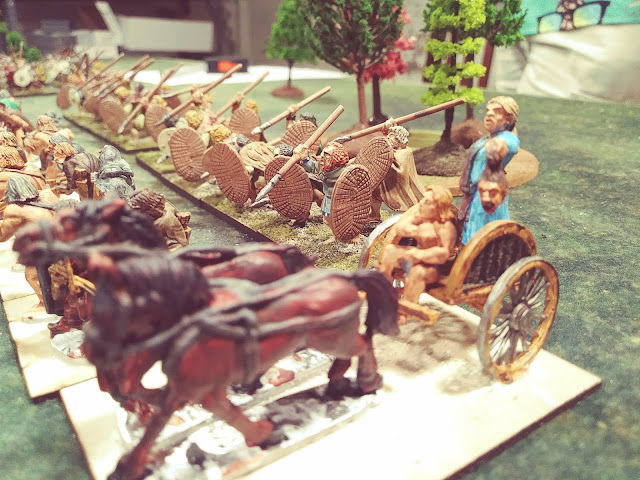- Shieldwall went from -1 for enemy's to hit target unit on shooting and melee to just a +1 armor – the -1s were making shieldwalls to powerful. I also added that a unit with the Shieldwall rule simple made a Courage test every time it was the target of a melee or shooting attack. If it passed the check the shieldwall was formed or "held", but it if failed it either broke in the face of the oncoming assault or failed to "form up" for whatever reason. All usual modifiers (cumulative casualties, leader with 12", other special rules) still applied to the Courage check, which gave some nice nuance, with units becoming more and more likely to not "hold the line" as their morale was worn down with casualties.
- The Gregarious rule (based on the "Warband 1 and 2" rules from WAB) was also dialed down a notch. Previously, at the end of a melee, a Gregarious unit received +1 to the resulting Courage check for every strength point by which it outnumbered or vice versa, so if the Saxons had 10 figures and the Britons 6, the Saxons would receive a +4. This is supposed to reflect a troop type who's confidence soars when they are doing well but crumbles when things don't look so good. In prior games this plus/minus was too "swingy", so it was reduced to a simple +1 if the Gregarious unit outnumbered its opponent, with an additional +1 if the Gregarious unit was still generating 12 melee dice and the enemy was only generating 6 (with a negative mod if situation reversed), so the max modifier was +2 or -2.
- The Impetuous Charge rule (also based on the "Warband 1 and 2" rules from WAB) is now only checked if the unit is within 6" of an enemy unit. On a "1" on a roll of a d6, the unit charges. Otherwise you may activate as normal. This eliminated units trying to charge from 48" away!
- Removed javelins from Irish ceithern units. Their base morale was also lowered by 1, added a rule where they received a +2 to courage checks if within 6" of their leaders' unit, reflecting the dependence of Irish ceithern to be inspired by a heroic leader.
- Picts are Fleet Footed and Hard to Target, but like the Irish had the "Ferocious Charge" rule wherein they reroll all misses in the first (and only the first) melee in which they are involved in the game.
The Celidon scenario had the Romano-British army (played by yours truly) retreating from a failed raid through the woods, who are then set upon by the Saxons and their Irish and Pictish allies/mercenaries (Jamie played these). The Britons needed to get three units, or two if one included the "army general" leader unit, off the opposite table edge. For a strategy I decided to shift my entire force to the left and try and run up the table edge, hoping the opposite Saxon flank would fail to come across in time to make a difference.
(Above: starting positions, Romano-British/Britons on the left)
(Above: Romano-British milites)
(Above: Jamie's Pictish chief)
This strategy immediately ran into trouble because the entire Saxon force moved forward quite quickly while the Britons were still trying to maneuver to the left, so that the net result was the Britons had not advanced forward hardly at all by the time the lines started to hit eachother – the opposite side of the table suddenly seemed very distant!
(Above: Romano-British suddenly find a large number of Saxons directly in front of them!)
(Above: Saxons prepare to attack a Romano-British shieldwall)
Second mistake was the Britons held their cavalry back instead of just having those two units sprint to escape. My thinking was I wanted the leader attached to one of the cavalry units to hang around and lend his +1 to Courage checks. The other reason was that the cavalry might be able to help break up some Saxon units and allow infantry to escape.
(Above: late Roman Legionaries posing as more Romano-British milites trained "in the Roman manner")
(Above: Romano-British foot trying to move to the left even as Saxons swoop in)
However, by about halfway through (our game "clock" would stop when both sides had combined to lose 8 units), it looked like the Britons' plan was going well – a few Saxon attacks had been repulsed by sturdy Shieldwalls and two or three Saxon army units had already broken or were on verge of breaking. Then came a key moment – a Saxon unit attacked a drilled Briton milites unit, and Britons did not hold their Shieldwall (even with their reroll from Drilled!)! The unit was shattered.
(Above: Picts advancing on Romano-British right)
(Above: things towards the end - Romano-British pedyt archers not doing well...)
"Now I know how the Romans felt at Teutoburg Forest!"









